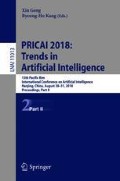Abstract
Judgment is a decision by a court or other tribunal that resolves a controversy and determines the rights and obligations of the parties. Since the establishment of the China Judgments Online System, more and more judgment documents have been stored online. With the explosive growth of the number of Chinese judgment documents, the need for automated classification methods is getting increasingly urgent. For Chinese data sets, traditional word-level methods often bring extra errors in word segmentation. In this paper, we proposed an approach based on character-level convolutional neural networks to automatically classify Chinese judgment documents. Different from traditional machine learning methods, we hand over the work of feature detection to the model. Throughout the process, the only part that requires human labor is labeling the category of each original documents. In order to prevent overfitting when the amount of training data is not very large, we use a shallow model which has only one convolution layer. The proposed approach does well in achieving high classification accuracy based on 7923 pieces of Chinese judgment documents. In the meanwhile, the effectiveness of our model is satisfactory.
Access this chapter
Tax calculation will be finalised at checkout
Purchases are for personal use only
References
Carreño, L.V.G., Winbladh, K.: Analysis of user comments: an approach for software requirements evolution. In: ICSE, pp. 582–591 (2015)
Hua, W., Wang, Z., Wang, H., Zheng, K., Zhou, X.: Understand short texts by harvesting and analyzing semantic knowledge. IEEE Trans. Knowl. Data Eng. 29(3), 499–512 (2017)
Maalej, W., Nabil, H.: Bug report, feature request, or simply praise? On automatically classifying app reviews. In: 23rd IEEE RE, pp. 116–125 (2015)
Paul, M.J.: Feature selection as causal inference: experiments with text classification. In: CoNLL, pp. 163–172 (2017)
Yang, Y., Yan, Y., Qiu, M., Bao, F.S.: Semantic analysis and helpfulness prediction of text for online product reviews. In: ACL, vol. 2, pp. 38–44 (2015)
Li, C., Huang, L., Ge, J., Luo, B., Ng, V.: Automatically classifying user requests in crowdsourcing requirements engineering. J. Syst. Softw. 138, 108–123 (2018)
Rousseau, F., Kiagias, E., Vazirgiannis, M.: Text categorization as a graph classification problem. In: ACL, vol. 1, pp. 1702–1712 (2015)
Grave, E., Mikolov, T., Joulin, A., Bojanowski, P.: Bag of tricks for efficient text classification. In: EACL, vol. 2, pp. 427–431 (2017)
Kim, Y.: Convolutional neural networks for sentence classification. In: EMNL, pp. 1746–1751 (2014)
Shang, L., Lu, Z., Li, H.: Neural responding machine for short-text conversation. In: ACL, vol. 1, pp. 1577–1586 (2015)
Ahn, S., Choi, H., Pärnamaa, T., Bengio, Y.: A Neural Knowledge Language Model. CoRR abs/1608.00318 (2016)
Johnson, R., Zhang, T.: Supervised and semi-supervised text categorization using LSTM for region embeddings. In: ICML, pp. 526–534 (2016)
Lai, S., Xu, L., Liu, K., Zhao, J.: Recurrent convolutional neural networks for text classification. In: AAAI, pp. 2267–2273 (2015)
Tang, D., Qin, B., Liu, T.: Document modeling with gated recurrent neural network for sentiment classification. In: EMNLP, pp. 1422–1432 (2015)
Zhang, X., LeCun, Y.: Text Understanding from Scratch. CoRR abs/1502.01710 (2015)
Lei, M., Ge, J., Li, Z., Li, C., Zhou, Y., Zhou, X., Luo, B.: Automatically classify chinese judgment documents utilizing machine learning algorithms. In: DASFAA Workshops, pp. 3–17 (2017)
Acknowledgment
This work was supported by the National Key R&D Program of China (2016YFC0800803).
Author information
Authors and Affiliations
Corresponding authors
Editor information
Editors and Affiliations
Rights and permissions
Copyright information
© 2018 Springer International Publishing AG, part of Springer Nature
About this paper
Cite this paper
Zhou, X., Li, C., Ge, J., Li, Z., Zhou, X., Luo, B. (2018). Automatically Classifying Chinese Judgment Documents Using Character-Level Convolutional Neural Networks. In: Geng, X., Kang, BH. (eds) PRICAI 2018: Trends in Artificial Intelligence. PRICAI 2018. Lecture Notes in Computer Science(), vol 11013. Springer, Cham. https://doi.org/10.1007/978-3-319-97310-4_49
Download citation
DOI: https://doi.org/10.1007/978-3-319-97310-4_49
Published:
Publisher Name: Springer, Cham
Print ISBN: 978-3-319-97309-8
Online ISBN: 978-3-319-97310-4
eBook Packages: Computer ScienceComputer Science (R0)

